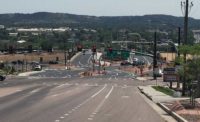The Colorado Dept. of Transportation and the U.S. 36 Express Lanes project team opened the state’s second diverging diamond interchange (DDI) at the McCaslin Boulevard bridge over U.S. 36 in early January.
Known locally as the “innovation corridor,” the U.S. 36 Express Lanes project was built with the strategy of moving traffic more efficiently. One innovation to help meet this goal was the addition of the DDI on the McCaslin Boulevard bridge at Louisville/Superior. The DDI, which was not originally part of the Phase 2 scope, is financed by the city of Louisville, the town of Superior and the Regional Transportation District, after a traffic study showed the efficiency and effectiveness of a DDI to be superior to other alternatives at the site.
The new McCaslin Boulevard interchange is one of 34 DDIs in the country but only the second in Colorado. The state’s first DDI in Grand Junction opened in early 2014. The DDI helps move traffic across the bridge more efficiently by moving vehicles to the opposite side of the road across the interchange. Then vehicles have unimpeded movement onto the highway ramps.
In addition, DDIs increase left-turn capacity, accommodate more traffic with fewer lanes and reduce delays by using a two-phase signal as opposed to traditional traffic signals. The bridge, which contractor Plenary Roads Denver began constructing last year, will still undergo construction over the next few months to finish sidewalks, landscaping and striping.
“Opening the state’s second DDI is truly a reason for celebration,” says CDOT Executive Director Shailen Bhatt. “We know construction is frustrating for drivers, but now anyone crossing U.S. 36 between Louisville and Superior can do so quicker and safer. DDIs will be more prevalent in Colorado and, in fact, we have one opening later this year in Colorado Springs.”
In addition to the DDI, new bus ramps were built under the on- and off-ramps to U.S. 36, allowing buses to get quickly on and off the highway without merging with general traffic, thus saving time for bus riders and improving the Flatiron Flyer BRT service, which began on Jan. 3.



